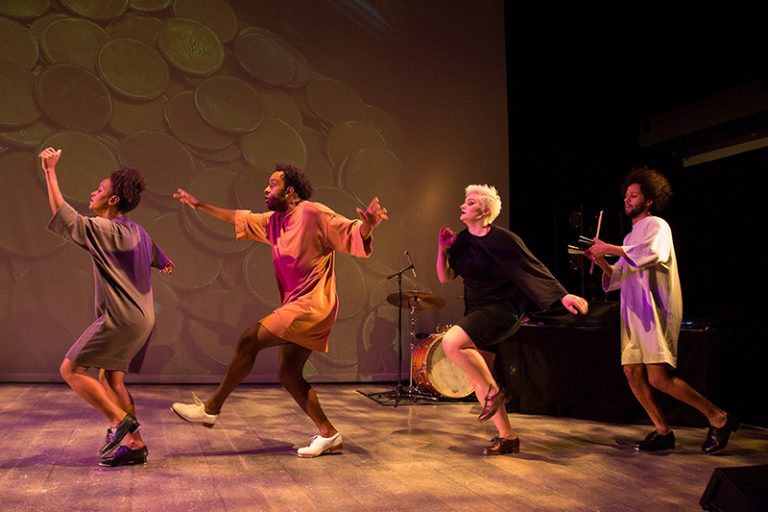All you need to do is look at the photograph of Leonardo Sandoval to discover a few key aspects of his work. First is that he clearly uses a dancer’s whole body as a mode of expression, which is not always the case with a traditional tap, where a dancer’s upper torso can be less active, and the focus is primarily on the footwork.
When you look at those four bodies dancing, you can hear the percussive rhythms of their feet right along with those from the instruments on stage. In an interview, I asked Sandoval to talk about being dubbed a true “dancer-musician.”
“This is something I love talking about!” Sandoval said. “One thing we as tap dancers always try to show is that tap dance is music — a tap dancer is a percussive musician as well as a dancer, and exploring the two sides opens up a lot of possibilities. The versatility is something that’s really unique to tap dancers.
“In my case, I always work with musicians, like my collaborator, composer Gregory Richardson [who is part of the performance at The Yard ]. We write music together with the sounds of the tap choreography as part of the score. Sometimes, a musical idea will influence the choreography, it really goes both ways. The main point is that as dancer-musicians, we are not dancers performing to a score — we are the score too!”
Sandoval answered more of my questions, providing even more insight into his work.
Can you talk about your combination of Brazilian dance, tap, and urban street dance?
Tap dance was the first dance form that was created and developed here in America. It was first developed by enslaved people as a way of communicating after drums had been taken away from them, and then it developed further in cities, especially in New York.
On the other hand, tap is also a style that allows each performer to find and share their own voice. I use the technique of tap dance to express my own voice, and since I’m Brazilian, my native dance and musical languages are Brazilian — samba, maracatu, forró, bossa nova, and so many other different styles that we have in Brazilian culture. I’m also interested in [American] urban dance like house, hip hop, and Brazilian “passinho,” as well as contemporary [modern] dance, and ballet.
The main thing [about my work] is a sense of shared culture — mixing forms like jazz and house dance with samba and passinho, I want to show that these forms are connected through common roots. Also, maybe a new perspective on the importance of rhythm and percussive music as a way of expressing yourself, your identity, and your personal background.
How did you train in the different strains of dance, and how did you decide and go about combining them into something unique?
I started dancing very young when I was 5 because my mom could see me dancing around the house all the time. I started with ballet, and very fast my ballet teachers noticed that I had very good rhythm, which I probably got from my father, who is a drummer. So, tap was sort of an obvious thing for me to do, combining dance with rhythm and a percussive element. I still continued doing ballet, as well as jazz dance, and hip hop. I never decided to combine the different styles — it’s just part of me and my background, and when I express myself through tap dance, that’s the voice that comes out, with all these different influences.
As you know, we have a large and important Brazilian community on Martha’s Vineyard. What would you like them to know about your work?
I’ve lived in the U.S. for around five years now, and more and more I think about what it means to be an immigrant here, especially one who is black and Latino. Even though every person’s experience is different, I think there are many things that we share as immigrants. Dance and music and combining Brazilian and American styles is my way of expressing this. I’m really looking forward to connecting with the Brazilian community on Martha’s Vineyard to celebrate this together and to also learn what their own perspective and experience are on the Island.
David White, the Yard’s artistic director, said, “Léo’s presentation is part of the Yard’s ongoing initiative, Tap the Yard: A Festival of Rhythm and Beats, which can involve periodic series or individual presentations such as Leo’s. The co-curators are Alison Manning, David Parker of the Bang Group, and me. And I’ve long wanted to work with Léo, not only because of his superb tap abilities, but because his Brazilian roots draw him to popular forms within his culture such as passinho, forró, and samba.”
The Vineyard audience will no doubt be glad he’s put Sandoval in this summer’s lineup.
Performances at the Yard will be Thursday, June 20, at 7 pm and Saturday, June 22, at 7 pm, and for families on Saturday, June 22, at 11 am. For tickets and a description of Sandoval’s two pieces “Partido” and “Phase,” visit dancetheyard.org/leonardosandoval.
This article by Abby Remer originally appeared on mvtimes.com.




